In the 1950s the Gros Michel banana was wiped out by the fungus TR1. Now a new strain, TR4, is threatening to destroy the near-universal Cavendish. Will industry learn its lesson this time?
A race against time. That’s how Alistair Smith, international co-ordinator at NGO Banana Link, sums up the battle against Tropical Race 4 (TR4). The devastating fungus, which chokes bananas of water and nutrients, has already ravaged crops across Asia, Africa and the Middle East, and shows no sign of slowing down.
If it reaches the Americas - from where the UK sources the bulk of its five billion-strong supply each year - we could see disruption to the supply of one of the UK’s most beloved fruits, 1.1 million tonnes of which are imported each year. “And there’s no scientist or politician that can reassure anybody it won’t suddenly spread to the main export production area,” adds Smith. It is - he reiterates - a “race against time”.
The thing is, this isn’t the first time the banana has faced such a threat. Rewind to the late 1950s and the export banana of choice, the Gros Michel, was all but wiped out by an earlier strain of the very same fungus. So, why is history repeating itself?
Undoubtedly disease is an inevitability of agriculture. It’s why Bayer has just paid £44.5bn for ‘agrochemical’ producer Monsanto. But the scale of the threat posed by TR4 is a direct result of the particularly susceptible way in which we grow and trade in bananas - namely our hefty reliance on a single variety. Despite there being more than 1,000 banana species available, 99% of exported bananas, and 47% of all bananas grown globally, are Cavendish bananas.
There are good commercial reasons for that. “Quite clearly growing huge expanses of the same thing provides economies of scale in production and that keeps prices down,” says Dr Stuart Thompson of the University of Westminster. Unlike the apple, say, where a virtue is made of the many British-grown varieties, the banana is only produced in tropical climates and so dealing with only one variety enables easier transport along the international supply chain. Once bananas are harvested and washed, they’re packed up into containers and loaded on to refrigerated ships to spend days, sometimes weeks, at sea. “Having bananas that ripen at the same time has clear advantages.”
“The export industry is fully designed to process Cavendish bananas from planting to delivery in the supermarket,” says plant pathologist Miguel Angel Dita Rodriguez. “It is not so easy to adapt the whole process for a new banana cultivar. It is also a question of managing consumer preferences. They are so familiar with the colour, shape and even the taste of Cavendish.”
At one time though, the robust but slightly bland taste of the Cavendish was considered second par, with the sweeter, creamier Gros Michel the banana of choice.
But when disease struck the ‘Big Mike’ in the form of TR1, the Cavendish - developed by a British nobleman in his Peak District greenhouse - was selected as a replacement for its resistance to the fungus, as well as its ability to withstand those long journeys.
It quickly became ubiquitous. Few UK consumers will have any other reference point for what a banana should look and taste like now, despite consuming on average 16.5kg of the tropical fruit each year.
“Rather than a low level economic nuisance, it flips to a catastrophe”
So what’s the problem? Well “if something breaches those defences then the whole system is unstable,” says Thompson, with any disease spreading quickly from identical banana to identical banana. “Rather than a low level economic nuisance, it flips to a catastrophe.”
In that way “its success is in many ways its curse,” says Professor Gert Kema of Wageningen University. “It’s a fantastic vehicle to spread disease and that’s exactly what’s happening now.”
First detected in Taiwanese crops in the late 1980s, TR4 has no cure once it gets its grip on a crop. Infected plants may show no symptoms for months and then leaves will start to yellow at the edges, the colour deepening as the plant’s oxygen supply is choked, while the thick fleshy trunk at the base of a plant splits, its insides blackened. “There is no known remedy,” says Smith. “It’s devastating.”
By the early 1990s, TR4 had made its way to Indonesia and Malaysia. In 2013 Mozambique. In subsequent years Lebanon, Israel, India, Jordan, Oman, Pakistan and Australia have all recorded infections. And in 2018 it reached Myanmar. There is some discussion as to exactly how it spreads, though on the muddy boots, clothes and equipment of people traipsing between banana plantations seems likely. It’s why Chiquita Brands International says it requires all its staff to leave any shoes and clothes worn on site, and is calling on governments to introduce similarly strict protocols.
It’s also why there is no guarantee the Americas won’t be infected. “All it would take is a few pieces of contaminated soil particles or infected plants,” says Fazil Dusunceli, agricultural officer at the FAO.
Let’s be clear: if that happens, the banana is not about to disappear from our supermarket shelves. “The Cavendish ultimately could suffer in terms of production volume, but the UK won’t run out of bananas,” says Andrew Biles, CEO at Chiquita. “They’ll probably just have to pay a bit more. There’ll also be less available for local consumption, but the export market will always be vibrant. They’re the ones that’ll pay better money for the fruit.”
But even if the UK can breathe a sigh of relief, there’s no doubt we urgently want to avoid any detrimental impact to a supply chain that involves 135 countries, 145 million tonnes of fruit and upon which 400 million people rely worldwide.
The banana industry at a glance
Bananas might be the world’s most exported fruit, but still less than 15% are exported to global markets, with the vast bulk consumed by the countries where the fruit is grown.
In fact, around 5% of the world’s population - 400 million people - rely on the banana as either a source of income, or a staple food in their diet.
A total of 135 countries currently grow the fruit, producing around 145 million tonnes of banana annually, with volume steadily growing in the past few years.
That’s true of the export market too, with global exports expected to total 19.2 million tonnes in 2018, says the UN, a growth of 4.4% from the previous year.
Ecuador and the Philippines remain the leading exporters of bananas while other major producers, such as Brazil, keep the majority of what they produce for the domestic market.
Forty-seven per cent of bananas grown worldwide - and more than 90% exported - are the Cavendish, the long, slightly curved and slightly sweet-tasting variety of the fruit that lines supermarket shelves across the UK.
However, there are more than 1,000 species grown worldwide, from the exceptionally sweet Apple Banana found in Hawaii to the snack-sized Lady Finger, the striking red banana and the pale cooking bananas treated more like potatoes than fruit, and often roasted or steamed into chips.
Here in the UK though, the banana of choice resolutely remains the Cavendish. Each year, we eat 16.5kg of them per capita, on average, importing 1.1 million tonnes and accounting for a little less than 1% of global production.
Our appetite for the fruit is increasing too. According to The Grocer’s Top Products Survey 2018, sales of bananas last year climbed 4.1% to a value of £574m - second only to apples and grapes, and higher than many British-grown produce such as strawberries and pears.
It’s a cut-throat business. As well as battling the threat of TR4, NGOs such as Banana Link say production is framed by a ‘race to the bottom’. Fuelled by the demand for low prices by western supermarkets (a single banana can cost as little as 14p) working conditions are often poor with few protections, while many working on plantations aren’t paid a living wage.
On average, workers only earn 5% to 9% of the value of the fruit, compared with retailers earning 36% to 43%, says the organisation.
What are the options?
So, what are the options? In the short term, of course, curbing the spread. Be that via more stringent travel protocols such as that advocated by Chiquita, or the development of more targeted fungicides, something that Kema says he is currently working on alongside industry. “I’m not necessarily a supporter of fungicides,” he says. But “if you have to choose between destruction or a fungicide, that choice is easy”. Crucially, though, these measures are sticking plasters. “It’s not the final sustainable solution.”
The ultimate answer is learning from the lessons of the past. That begins with innovation and research into a crop for which farming processes have been stagnant for a century. “Banana culture has been extremely traditional for 100 years,” says Kema. “If you compare that to other crops there’s a lot of innovation ongoing, production has quadrupled in many cases, quality has improved, there’s lots of diversity - nothing like that has happened in bananas.”
Which, given the devastation that TR1 wrought on the Gros Michel, is hard to believe. “What I can’t get my head around is that if the Cavendish saved the industry 70 years ago, and due to that success it became globalised and is now grown all over the world, why has nobody tried to understand why? There’s a tremendous breadth of potential to innovate the crop.”
Finally, the industry is cottoning on, however, with a multitude of academic and industry-led projects happening worldwide.
In some cases that means the development of bananas made resistant to TR4 via GM or gene editing techniques. Much was made of a breakthrough in Australia in 2017 when scientists discovered a gene that contributed to resistance, and inserted it into banana plants. A subsequent field trial proved the modified plants could successfully withstand the disease.
For the EU and UK though - where a 2018 ruling applied the same restrictions to gene editing as GM - this isn’t a viable solution. “And I wouldn’t propose it to be,” says Biles. “Those are the rules of the game. We need to understand bananas in a way we haven’t before and find natural ways of breeding new varieties.”
Resistance
One research team in Taiwan has been focusing on just that, exposing seedlings of the Cavendish banana to contaminated soil, selecting those that show the most resistance and painstakingly narrowing down their selection pool, with only two or three varieties per 10,000 showing promise. Earlier this year their efforts bore fruit with the development of a line of Cavendish that has some resistance to TR4.
Simply replacing the current Cavendish with another variety resistant to the current disease du jour - whether GM, gene-edited or selectively bred - won’t cut it, however. The only viable long-term solution is greater diversity and a move away from the monoculture model that got us into this mess in the first place.
The current threat “has provoked for better or worse, a calling into question of the monoculture model,” agrees Smith.
Consumers will be open to a move away from monocultures too, believes Biles. “I think the consumer of old perhaps was one that was faithful to what they liked, but the new consumer has a desire for choice.”
There are challenges, of course. “In an ideal world we’d be growing things in a more diverse way, where you wouldn’t have fields upon fields of the same variety of the same species, but we’ve got into this situation where intensive agriculture is necessary to sustain the population we have,” says Thompson. “You can grow intensively with more diverse crops but it requires more manpower, because you’ve not just got a huge field of the same plant. It requires more individual attention.”
Companies won’t give up cheap bananas easily, believes Professor Altus Viljoen, of Stellenbosch University. “Agriculture is a business. High yields, cheap labour and quality produce increase profitability. The Cavendish banana is not yet in the same trouble as Gros Michel was, but the threat might be greater. Still, little appears to be happening for the replacement of the Cavendish banana. “I am not sure if such changes would be supported by suppliers and retailers, as their business is in trade and making money.”
Major suppliers say differently, with both Chiquita and Fyffes insisting they’re looking closely at new varieties. Though this “is not a 12 or 18-month project, this is probably a 10 to 15-year project, probably indefinite, to breed new bananas and better understand its genes”, says Biles. “There’s no instant fix and one has to be committed to finding a solution.” Indeed. Or risk looking on helplessly as history repeats itself for a third time.
Three projects looking to reinvent the banana
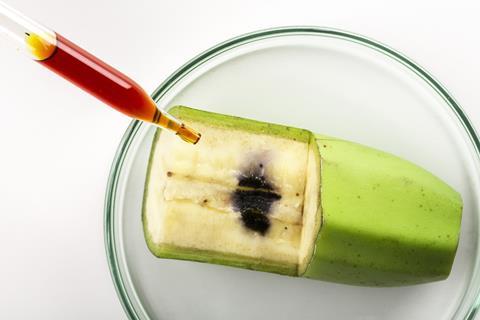
UK
BananEx is a three-year, £1.2m project at the University of Exeter set up in 2016 with the aim of securing ‘the future of the UK’s favourite fruit.’
The academic group, run by Dr Dan Bebber, says it is working with retailers and other stakeholders to better understand the vulnerabilities of the banana and build a blueprint for resilience. Bebber wrote in April: as TR4 ‘continues its westward march towards the new world, the banana supply chain approaches a crossroads: will the status quo be maintained, or will a new route be taken?’
Australia
In 2017 a team at Queensland University successfully grew GM- resistant Cavendish bananas in TR4-contaminated soil, a feat that attracted much media attention. The team inserted a resistant gene taken from a wild banana into the Cavendish and exposed it to TR4, an exposure the plant survived in field controls. Project lead Professor James Dale said the achievement was a major step forward in the fight against the disease, though EU regulation would prohibit GM bananas being imported into the UK.
Taiwan
Work to battle against TR4 has been ongoing in Taiwan for years, one of the countries where the pathogen was first detected. There researchers have taken a more traditional approach, identifying disease resistant Cavendish bananas via advanced selective breeding. This requires mass plantings in infected soil before selecting the mutants - the tissue cultures that survive - in order to develop resistant varieties. Some concerns remain around the quality and robustness of these bananas, though.







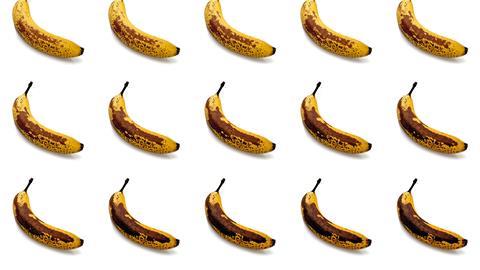






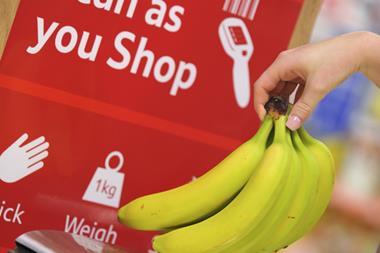
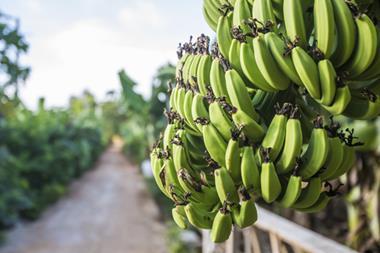

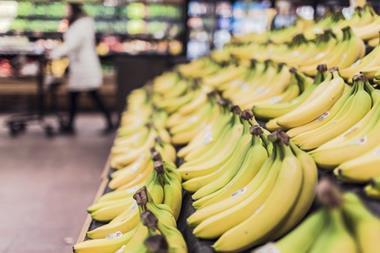







No comments yet